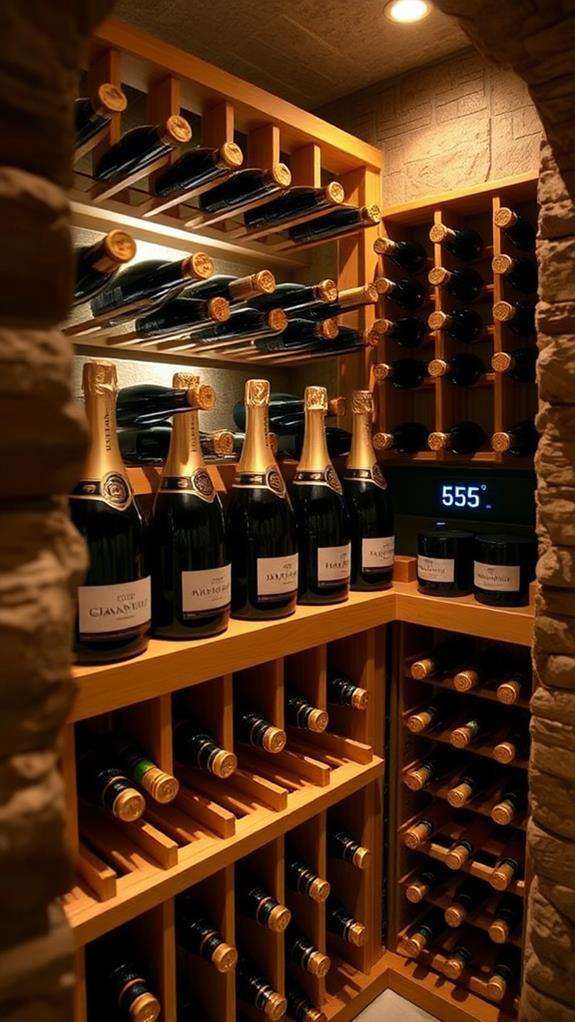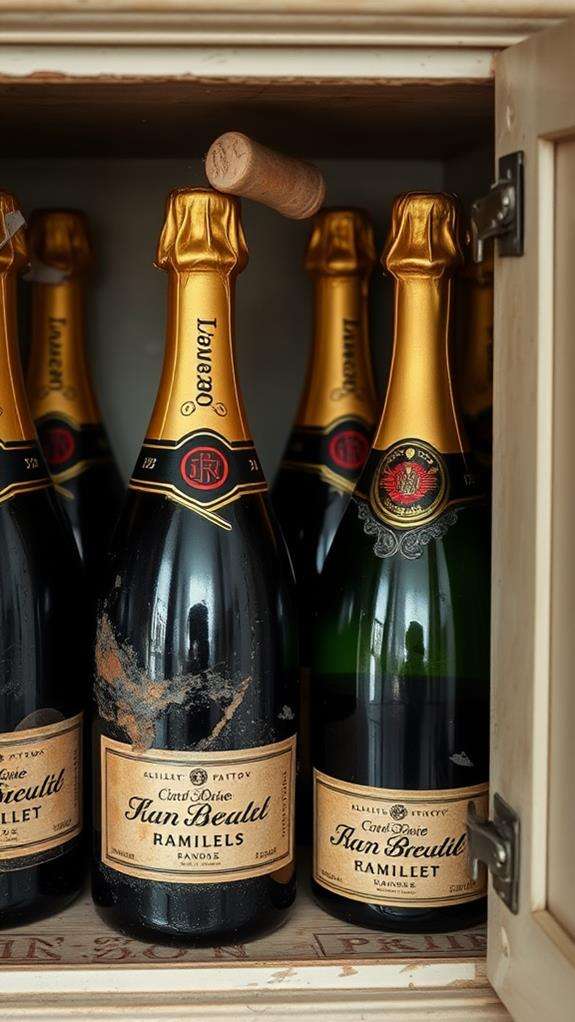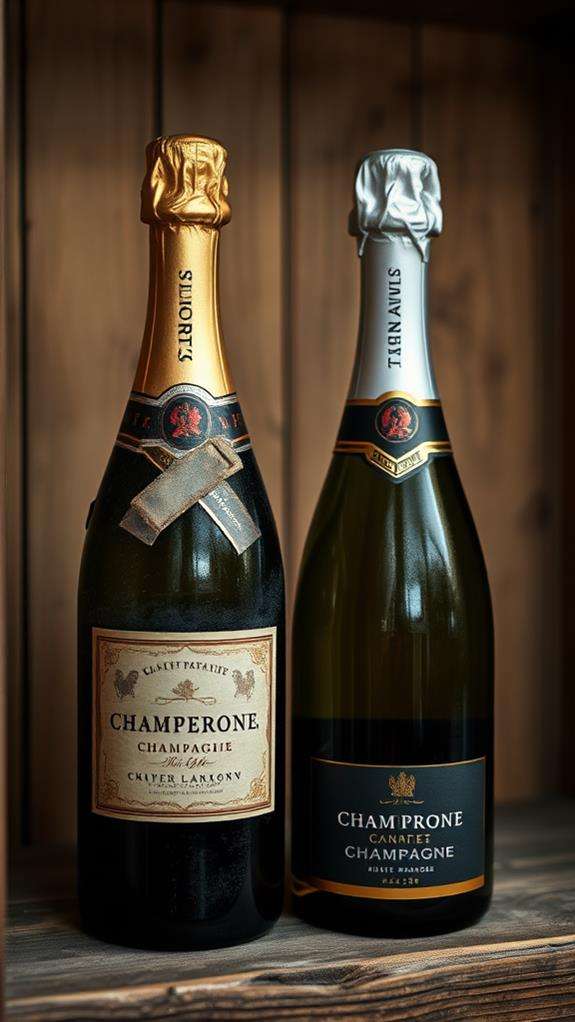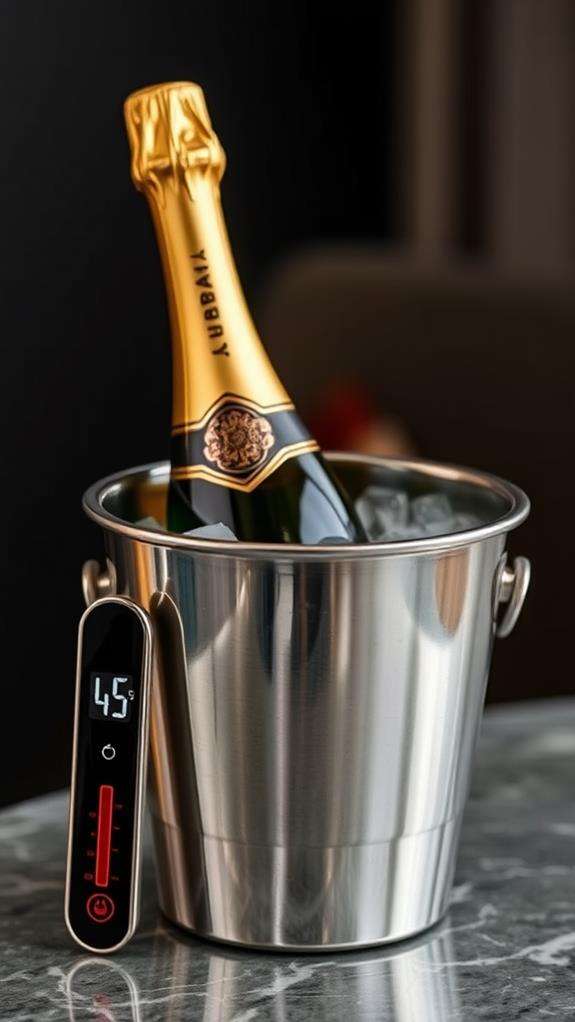How Long Does Unopened Champagne Last
Your unopened champagne's shelf life depends on its type and storage conditions. Non-vintage varieties typically last 3-4 years, while vintage champagnes can age beautifully for 5-10 years or longer. To maximize longevity, store your bottles horizontally at 55°F (13°C) in a dark, humid (70-75%) environment away from vibrations and strong odors. You'll know your champagne has spoiled if it shows signs like brown coloration, musty aromas, or weak bubbles. Proper storage is essential – a perfectly maintained bottle will retain its crisp, effervescent character and develop complex flavors over time. Understanding the nuances of champagne preservation can transform your collection from good to exceptional.
This post may contain affiliate links. If you make a purchase through these links, I may earn a commission at no additional cost to you. Additionally, portions of this post may be generated using artificial intelligence (AI) technology. While we strive for accuracy, please be aware that AI-generated content may not always be perfect and should be fact-checked when necessary.
The Spatula Scoops
- Non-vintage Champagne can last 3-4 years when stored properly at 55°F with appropriate humidity levels.
- Vintage Champagne has longer aging potential, lasting 5-10 years or more when stored horizontally in optimal conditions.
- Proper storage conditions, including consistent temperature and humidity, directly impact Champagne's longevity and quality.
- Horizontal storage keeps the cork moist and prevents oxidation, extending the Champagne's shelf life significantly.
- Signs of spoilage include brown coloration, musty aromas, or weak bubbles, indicating the Champagne has exceeded its storage life.
Types of Champagne Storage

Before storing your champagne, you'll need to choose between two main storage methods: horizontal and vertical positioning. While both methods can work, horizontal storage is often considered ideal for long-term preservation, as it keeps the cork moist and prevents it from drying out and shrinking.
When you're storing champagne horizontally, you'll want to use wine racks specifically designed to cradle the bottles at a slight angle, guaranteeing the wine maintains constant contact with the cork. This position helps prevent oxidation and maintains the champagne's effervescence. If you don't have a dedicated wine rack, you can use a sturdy cardboard box lined with dividers.
Vertical storage, while less preferred for extended periods, can work for bottles you'll consume within a few months. You'll need to ascertain the bottles are kept upright in a stable position, away from direct light and vibration. If you're storing vertically, it's best to keep the champagne in its original packaging or use specialized wine storage boxes that provide adequate support and protection. Remember, whichever method you choose, consistency in temperature and humidity levels is vital for proper preservation.
Optimal Storage Conditions

Proper storage methods work best when paired with the right environmental conditions. To keep your champagne in prime condition, you'll need to maintain a consistent temperature between 45-65°F (7-18°C), with 55°F (13°C) being ideal. Fluctuating temperatures can cause the cork to expand and contract, potentially compromising the seal and the wine's quality.
You'll want to store your bottles horizontally in a dark, humidity-controlled space with 70-75% relative humidity. This position keeps the cork moist, preventing it from drying out and allowing unwanted oxygen to seep in. Light exposure, particularly UV rays, can trigger a chemical reaction called "light strike," which causes your champagne to develop unpleasant sulfur notes.
Avoid storing your champagne near appliances that vibrate, as movement can disturb the sediment and disrupt the aging process. Your storage area should be free from strong odors, as champagne can absorb them through the cork. If you don't have a wine cellar, a dedicated wine refrigerator or a cool, dark closet away from your kitchen will serve as suitable alternatives.
Signs of Spoiled Champagne

Your champagne's appearance, aroma, and taste provide clear indicators of spoilage. When examining your bottle, check for changes in color, bubbles, and sediment that might signal deterioration. You'll want to look for these specific warning signs before serving or consuming the champagne.
| Indicator | Normal Signs | Warning Signs |
|---|---|---|
| Color | Golden to light straw | Brown or dark amber |
| Aroma | Fresh, yeasty, fruity | Vinegar-like, musty |
| Taste | Crisp, effervescent | Flat, sour, chemical |
If you notice the champagne's color has darkened considerably or turned brownish, it's likely oxidized. The bubbles should be vigorous and persistent when poured; if they're weak or absent, that's a red flag. You'll also want to check for any unusual sediment or floating particles, which shouldn't be present in properly stored champagne. When you open the bottle, the cork shouldn't be dried out, crumbly, or pushed out. A vinegar-like smell or musty aroma indicates bacterial growth or improper storage. Trust your senses – if anything seems off about your champagne's appearance, smell, or taste, it's better to err on the side of caution.
Vintage Vs Non-Vintage Shelf Life

Understanding the difference between vintage and non-vintage champagne storage is essential for maximizing shelf life. Non-vintage champagne, which blends wines from multiple years, typically lasts 3-4 years when stored properly, while vintage varieties can age beautifully for 5-10 years or even longer.
You'll find that vintage champagne, produced from grapes harvested in a single exceptional year, contains complex compounds that allow for extended aging. If you're storing a vintage bottle, you can expect it to develop deeper flavors and more intricate aromas over time. The higher acidity and structural components in vintage champagne act as natural preservatives, contributing to its longer shelf life.
In contrast, non-vintage champagne is designed for earlier consumption. You'll want to drink these bottles within their recommended timeframe to enjoy their fresh, vibrant characteristics. While proper storage conditions remain vital for both types, you should pay extra attention to vintage bottles, keeping them at a consistent temperature of 50-55°F (10-13°C) and away from light. Remember that the champagne house's reputation and specific vintage year can also influence how well the wine ages.
Best Serving Temperature Guidelines

When it comes to serving champagne, temperature plays a essential role in maximizing its flavor profile and effervescence. You'll want to serve your bubbly at the right temperature to guarantee you're experiencing its full range of aromas and tastes. While many people serve champagne straight from the refrigerator, this isn't always ideal.
| Style of Champagne | Recommended Temperature |
|---|---|
| Vintage | 54-57°F (12-14°C) |
| Non-Vintage | 46-50°F (8-10°C) |
| Rosé | 46-50°F (8-10°C) |
| Demi-Sec | 43-46°F (6-8°C) |
| Prestige Cuvée | 50-54°F (10-12°C) |
To achieve the perfect serving temperature, you'll need to plan ahead. If your champagne's been stored at room temperature, place it in the refrigerator for about three hours before serving. Don't use the freezer as a shortcut—rapid temperature changes can damage the wine's quality. For precise temperature control, you can use an ice bucket filled with equal parts ice and water, which will chill your bottle in about 20-30 minutes. Remember to check the temperature with a wine thermometer for best results.
Frequently Asked Questions
Can Champagne Be Stored in the Freezer?
You shouldn't store champagne in the freezer, as it can be dangerous and damaging. The liquid inside will expand when frozen, potentially causing the bottle to explode or the cork to pop violently. Additionally, freezing temperatures will alter the champagne's delicate flavors and destroy its signature bubbles. If you need to chill champagne quickly, use an ice bucket with water and ice for 20-30 minutes instead.
Does Champagne Improve With Age Like Regular Wine?
While you might think champagne ages like fine wine for a million years, it's actually quite different. Unlike most red wines, most champagne won't improve with age. You'll find that non-vintage champagnes are best consumed within 3-4 years of purchase, while vintage varieties can age for 5-10 years when stored properly. The wine's unique production process means it's typically ready to drink when it's released, so there's no need to wait.
What Happens if Champagne Is Exposed to Sunlight During Shipping?
When your champagne's exposed to sunlight during shipping, you'll face several potential issues. The UV rays can trigger chemical reactions that'll alter the wine's taste and aroma, leading to what's called "light strike" or "goût de lumière." You'll notice unpleasant sulfur-like flavors and a diminished quality. That's why quality champagne typically comes in dark bottles and protective packaging. Even brief exposure can start this damaging process.
Can I Store Champagne Bottles Upright Instead of Horizontally?
Like a graceful dancer, your champagne needs to rest on its side, not stand at attention. You shouldn't store bottles upright because this allows the cork to dry out, which can lead to oxidation and spoilage. When you lay the bottle horizontally, the wine stays in contact with the cork, keeping it moist and expanded. This creates a tight seal that'll protect your bubbly's quality and prevent unwanted air from seeping in.
Does the Size of the Champagne Bottle Affect Its Shelf Life?
Yes, the size of your champagne bottle directly impacts its aging potential. Larger formats, like magnums (1.5L) and jeroboams (3L), typically age better than standard 750ml bottles because they've got less oxygen relative to the wine volume. You'll find that bigger bottles develop more slowly and maintain their quality longer. That's why collectors often prefer magnums for long-term storage, as they'll preserve the wine's freshness and complexity more effectively.





